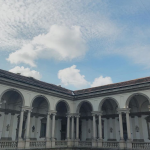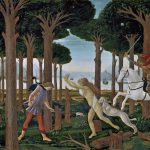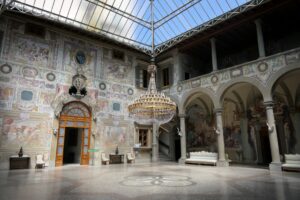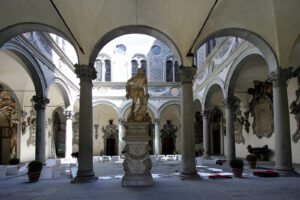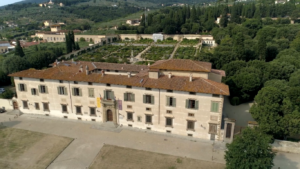Prada Foundation, Brera Gallery, the Museum of Cultures and more
The botanical garden in Brera
A miracle of greenery amid the buildings of Milan
The botanical garden in Brera is a miracle of greenery amid the buildings of Milan, with 300 different species and five thousand square metres! It dates from the end of the 18th century and it has a very special atmosphere.
For anyone wanting to learn more about art through botany, there is an interesting little learning-through-play booklet: “Arte e Orto” (Art and Garden) It incorporates everything there is in Brera’s picture gallery!
⇒ Watch the full web serie Milan & Leonardo da Vinci
Visit Milan University official website
Visit Turismo Milano official website
Video full text: The botanical garden in Brera
Brera’s picture gallery was established in 1773,
when the Jesuits were evicted by Maria Theresa of Austria,
who wanted to give the scholars additional space.
She found it here, in a place that had, until shortly before, belonged to the Jesuits.
Influenced by the French Enlightenment, Maria Theresa
maintained that a great empire, such as that of the Habsburgs,
had to put into practise important cultural projects.
In Lombardy she reformed education,
and in Milan, in addition to creating La Scala Theatre,
she created the Academy of the Arts and the picture gallery in Brera.
But what interests me is what there is behind all of this:
at the back of Brera there is a botanical garden!
The word Brera, or breida in old Milanese, is supposed to mean fallow land.
All of this was outside of Milan,
and until the 12th century this area was right in the middle of the little-cultivated countryside.
In the 16th century the Jesuits transformed the 14th century convent into a place of learning.
Finally, in the 18th century, the Austrians planted this garden,
Maria Theresa, naturally.
Brera’s botanical garden, with its 300 different species and five thousand square metres,
is a miracle of greenery amid the buildings of Milan.
It’s one of Milan’s most interesting places,
even from the point of view of gardening techniques.
Not simply because it is a botanical garden that dates from the end of the 18th century.
This garden has a very special atmosphere.
The garden was designed by Fulgenzio Vitman, with an educational purpose in mind,
and the project includes two tanks for collecting water.
The water came from the Navigli and the canals of the Martesana,
Milan’s water system, designed centuries before by Leonardo da Vinci.
At the peak of the age of enlightenment, at the same time as the botanical garden,
the Habsburgs decided they also wanted to build an astronomical observatory.
And so, in the second half of the 18th century, Brera was to become
a point of reference for artists and scientists.
This shower of leaves falls onto the heads of the students of Brera,
who are at this moment studying… a magical moment!
If I’m not mistaken I see a persimmon tree over there,
it looks like a tree from a fairy tale!
It’s more than likely that the tree of Eden was not an apple but a persimmon tree.
For anyone wanting to learn more about art through botany,
there is an interesting little learning-through-play booklet: “Arte e Orto” (Art and Garden)
It incorporates everything there is in Brera’s picture gallery,
for example, this beautiful picture by Simone Peterzano,
that also depicts a pomegranate, with a real pomegranate,
that can be found in the botanical garden.
There’s another plant, painted by none other than Raphael, in the Marriage of the Virgin.
Saint Joseph, who is a guest at the wedding, is holding an oleander flower in his hand.
In The Resurrection of Christ, by Giovanni Cariani, that is on display in Brera, we see an olive tree and here it is!
Inside the botanical garden there is a hyper-technology path, created for the visually impaired.
Microchips have been placed under the ground and the stick acts as a sort of antenna,
picking up the messages from the microchip and sending them to a smartphone.
The visually impaired person can listen to the message.
That’s really hi-tech!
And it’s not just useful for the visually impaired, naturally.
Rather than seeing the trunk of the Virginia persimmon, it is possible to feel it.
You can touch the exterior, that is made up of coarse, square-shaped scales that look a bit like tiny squares of chocolate.
This is the first time that I have caressed aromatic leaves with my eyes shut,
and smelled the aromas of exotic plants.
the Japanese sage has very large aromatic leaves.
It is fantastic to touch.
the cotton plant has palmate leaves with three or five lobes
How lovely, it’s already like this! Ready for use.
Here I am, standing under two Ginkgo bilobas, trees that are the symbol of Brera’s botanical garden.
the ginko has remained virtually unchanged for more than 200 million years,
which is why it is referred to as a living fossil.
The leaves of the ginkgo biloba are beautiful and fan-shaped.
They turn yellow in autumn.
It is the oldest tree in the world, and it was around the time of the dinosaurs.
These two trees here are two hundred years old,
one is male and the other female.
This tree is also the symbol of the vegetable plot-garden.
A place that is hidden away, but not that much.
Let’s try and keep it as hidden away as possible,
don’t tell anyone!
Visit Milan: helpful hints
Italian name: Milano
Arrival
Milan has got three airports:
- Malpensa Airport is the largest international & intecontinental Airport in Northern Italy. 30 miles Northwest from the city centre. Connections:
→ Train Malpensa Express: trains leaves every 30 minutes in each direction, connecting the Airport to Milan Grand Central Station or Cadorna Railway Station. Terminals 1 and 2. It takes 45 min, price: 14 €
→ Shuttle Bus: Malpensa Shuttle and Malpensa Bus Express connect the airport to Milan Grand Central Railway Station and Milan’s Underground Network. Terminals 1 and 2. It takes 60/70 min, price: 8 € - City Airport Linate is an international airport connecting Milan with main European cities, located just 4 miles from the city centre. Connections by shuttle: Atm Bus n. 73 from Milano Duomo M1 – M3 (Piazza Diaz, direction: San Babila), first ride at 5.35 am, last one at 00.35. Frequency: every 10 min, price 1,5 €
- Milan Bergamo Airport Orio al Serio is mainly low cost flights Airport, located 30 miles Northwest from Milan. Connections only by Shuttle: There are 4 different bus companies, pricing changes from 5 up to 8 €
Transports
ATM is Milan public transport service both for bus, tram and subway. Single ticket costs 1.50€ for 90-min ride. Consider daily/weekly subscriptions. You can buy tickets also texting to 48444. Milan Subway is the longest in Italy, covering 95 km: Donwload and check the map.
Moving in town can be nice also by bike: Milan has got a powerfull bike sharing service providing both regular and e-bikes. Here is the experience of our Ambassador Kim Harding with BikeMi service and a useful video of our Ambassador Roxana explaining how does it work. Car Sharing is also good with many different companies to choose.
Try also the local urban railway train, called Passante Ferroviario, check the experience of our Ambassador Roxana Iacoban travelling by local train in town.
What to do in Milan
Milan is the Italian financial center and one of the European capitals of Fashion. Known for its nightlife as well.
Some tips on Italia Slow Tour: watch our web serie about Leonardo da Vinci’s places, climb on top of the Duomo, visit Prada Foundation, Museums and Art Galleries, taste some fine gelato and try the local Aperitivo and – not joking – enjoy a sailing trip (!!) or some time deep in the nature close to some actual farms and fields.
Where to sleep
Accomodations are quite expensive in Milan, fares rise up and hotels get full according to the rich event calendar of the city (see: Fashion Week, Salone del mobile, Big concerts, Theatre and Sport events, etc.). If you are not specifically interested in any of those, try to travel during other periods to save some money.
Italia Slow Tour recommends:
- Hotel Cervo in Garibaldi District if you want to stay close to city centre and enjoy the nightlife
- Hotel Concorde located on the Green Way Milan-Lecco to Lake Como, if you want to move around adn travel by bike
Shopping in Milan
The famous Fashion District involves the following streets/areas: Via Montenapoleone, via Manzoni, via della Spiga and Corso Venezia. The so called “Quadrilateral of Fashion”. Here you can find all kind of brands and shops. Easy to reach by Subway (stop at Montenapoleone station).
Don’t miss the Street Markets! Almost every day you can find one: best are the ones in Viale Papiniano (on Tuesday) and Via Fauchè (on Saturday). More on the official website of weekly street markets. If you are into sustainable local products, Milan has got 8 actual farms in town and a green Earth Market.
If you are interested in Outlet Shopping, in the outskirt of Milan you can find 4 different Fashion Outlets, in a radius of 62 miles. Here you can find everyday a lot of famous high quality Italian brands on sale, with prices cut off up to 50%. All the outlets are connected to the center of Milan by Shuttle Bus:
- Serravalle Designer Outlet – Shuttle departure from Milan Central Station or Cairoli square
- Fidenza Village Outlet Shopping – Shuttle departure from Piazza della Repubblica 5, at the corner with Turati st.
- Vicolungo The Style Outlets – Shuttle departure from Cairoli square
- Rodengo-Saiano Franciacorta Outlet Village – Shuttle departure from Cairoli square

